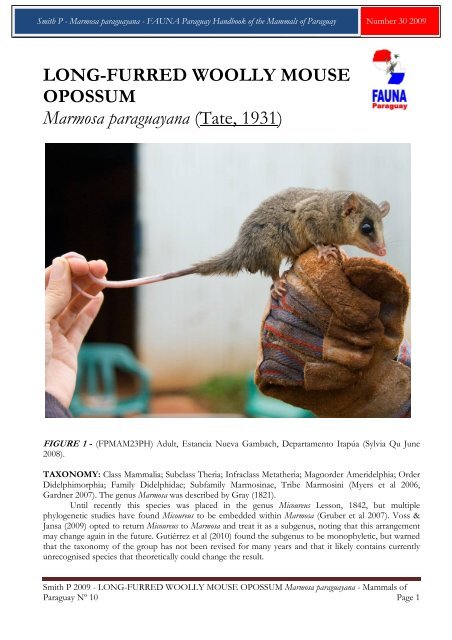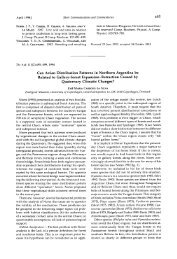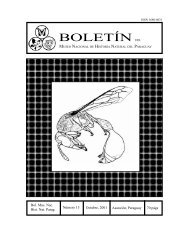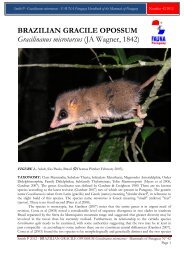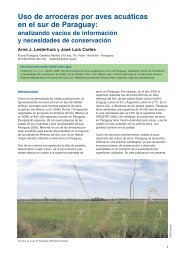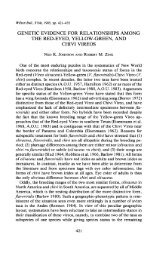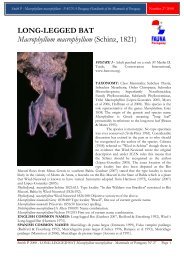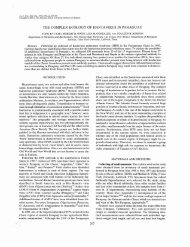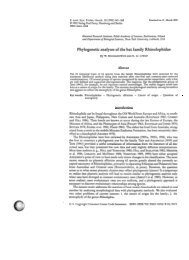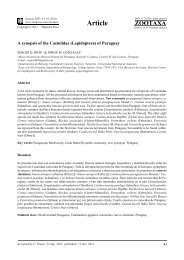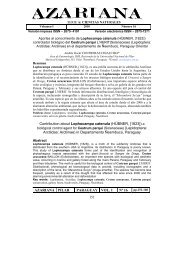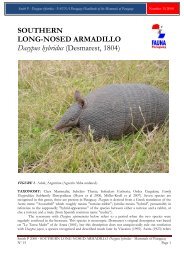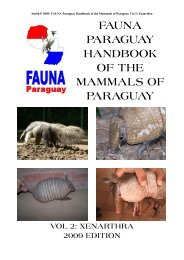Smith P 2009 - FAUNA Paraguay
Smith P 2009 - FAUNA Paraguay
Smith P 2009 - FAUNA Paraguay
Create successful ePaper yourself
Turn your PDF publications into a flip-book with our unique Google optimized e-Paper software.
<strong>Smith</strong> P - Marmosa paraguayana - <strong>FAUNA</strong> <strong>Paraguay</strong> Handbook of the Mammals of <strong>Paraguay</strong> Number 30 <strong>2009</strong><br />
LONG-FURRED WOOLLY MOUSE<br />
OPOSSUM<br />
Marmosa paraguayana (Tate, 1931)<br />
FIGURE 1 - (FPMAM23PH) Adult, Estancia Nueva Gambach, Departamento Itapúa (Sylvia Qu June<br />
2008).<br />
TAXONOMY: Class Mammalia; Subclass Theria; Infraclass Metatheria; Magnorder Ameridelphia; Order<br />
Didelphimorphia; Family Didelphidae; Subfamily Marmosinae, Tribe Marmosini (Myers et al 2006,<br />
Gardner 2007). The genus Marmosa was described by Gray (1821).<br />
Until recently this species was placed in the genus Micoureus Lesson, 1842, but multiple<br />
phylogenetic studies have found Micoureus to be embedded within Marmosa (Gruber et al 2007). Voss &<br />
Jansa (<strong>2009</strong>) opted to return Micoureus to Marmosa and treat it as a subgenus, noting that this arrangement<br />
may change again in the future. Gutiérrez et al (2010) found the subgenus to be monophyletic, but warned<br />
that the taxonomy of the group has not been revised for many years and that it likely contains currently<br />
unrecognised species that theoretically could change the result.<br />
<strong>Smith</strong> P <strong>2009</strong> - LONG-FURRED WOOLLY MOUSE OPOSSUM Marmosa paraguayana - Mammals of<br />
<strong>Paraguay</strong> Nº 10 Page 1
<strong>Smith</strong> P - Marmosa paraguayana - <strong>FAUNA</strong> <strong>Paraguay</strong> Handbook of the Mammals of <strong>Paraguay</strong> Number 30 <strong>2009</strong><br />
Currently there are six recognised species in the subgenus Micoureus (Gardner 2007) two of which<br />
are present in <strong>Paraguay</strong>. The subgenus Micoureus is probably taken from the Guaraní/Tupi indigenous<br />
name for an opossum Mykuré. The species name paraguayana refers to <strong>Paraguay</strong> the country of provenance<br />
of the type specimen. The species is monotypic.<br />
Formerly considered conspecific with the Woolly Mouse Opossum M.demerarae (O.Thomas, 1905),<br />
the Atlantic Forest form was described by Tate (1931) as Micoureus cinerea paraguayanus, with type locality<br />
"Villarica, <strong>Paraguay</strong>". Tate (1933) was unwittingly referring to this species in part when making his<br />
description of Micoureus cinerea, though for the cranial characteristics he relied on three different specimens<br />
from Pará, Pernambuco and Rio de Janeiro. As currently understood only the Rio de Janeiro specimen<br />
would today be referrable to M.paraguayana, the others likely being M.demerarae dominus (Gardner 2007).<br />
More recently the names Micoureus limae (Patton, Silva & Malcolm 2000) and Micoureus travassosi (Patton &<br />
Costa 2003) have been used for the species. Synonyms adapted from Gardner (2007):<br />
Didelphis cinerea Temminck 1824:46. Type locality "Brésil" restricted by Tate 1933:55 to Río Mucurí, Bahía,<br />
Brazil.<br />
Micoureus cinereus Lesson 1842:186. Name combination.<br />
Philander cinerea Gray 1843:101. Name combination.<br />
Didelphys [(Metachirus)] cinerea Burmeister 1854:137. Name combination.<br />
Didelphys [(Micoureus)] cinerea O.Thomas 1888:342. Name combination.<br />
Grymaeomys cinerea Winge 1893:46. Name combination and incorrect gender.<br />
[Didelphys (Marmosa)] cinerea Trouessart 1898:1238. Name correction.<br />
Marmosa cinerea O.Thomas 1901:536. Name combination.<br />
[Didelphis (Caluromys)] cinerea Matschie 1916:269. Name combination.<br />
[Marmosa (Marmosa)] cinerea cinerea Cabrera 1919:36. Name combination.<br />
Marmosa (Micoureus) cinerea Pohle 1927:241. Name combination.<br />
Marmosa cinerea paraguayana Tate 1931:1. Type locality "Villa Rica", Guairá, <strong>Paraguay</strong>.<br />
[Micoures] cinereus Reig, Kirsch & Marshall 1985:342. Name combination.<br />
Micoures cinerea paraguayana Massoia 1988:6. Name combination and incorrect gender.<br />
[Micoureus demerarae] paraguayana Gardner 1993:20. Name combination and incorrect gender.<br />
Micoureus cinereus paraguayanus González, Marques & Pacheco 1997: 195. Name combination.<br />
[Micoureus] limae Patton, Silva & Malcolm 2000:72. Name combination.<br />
[Micoureus] travassosi Patton & Costa 2003:75. Name combination.<br />
Micoureus paraguayensis Gardner 2007:77. Name combination and transcription error.<br />
Marmosa paraguayana Voss & Jansa <strong>2009</strong>:77. Name combination<br />
ENGLISH COMMON NAMES: Long-furred Woolly Mouse Opossum (Wilson & Cole 2000, Brito &<br />
Fonseca 2007, Canevari & Vaccaro 2007), Tate´s Woolly Mouse Opossum (Gardner 2007), Woolly Mouse<br />
Opossum (Barros et al 2008).<br />
SPANISH COMMON NAMES: Marmosa grande gris (Redford & Eisenberg 1992, Massoia et al 2000),<br />
Comadrejita cenicienta (Massoia et al 2000), Comadrejita gris (Canevari & Vaccaro 2007), Marmosa lanuda<br />
de pelo largo (Emmons 1999).<br />
GUARANÍ COMMON NAMES: Anguyá-mykuré (Massoia et al 2000), Guaikí (Massoia et al 2000).<br />
DESCRIPTION: A large stocky mouse opossum with relatively short snout and long, thick, woolly<br />
pelage. Head somewhat triangular in profile. Dorsal pelage uniform greyish, sometimes with a slight<br />
brownish tinge. Ventrally creamy-yellow or buffy-white, the colour extending onto the chin, laterally<br />
towards the cheeks and on the face up between the eyes. Eyes large and dark, accentuated by black<br />
patches around the eyes which extend slightly in a point towards the snout. Ears large, slightly pointed but<br />
with rounded tips and brownish-pink in colour. Nose pinkish. Feet are broad and pinkish, the claws of the<br />
forefeet extending slightly beyond the digital pads. Thenar and first interdigital pads are fused on the<br />
hindfoot but lie together on the forefoot. Fourth interdigital pad lies against the hypothenar pad of the<br />
forefoot but the two are either fused or in direct contact on the hindfoot. Central part of the soles of all<br />
feet are smooth. Digit IV on the hindfoot is longest with a length ratio of 0.45 when compared to the<br />
hindfoot length. Second and third interdigital pads on all feet are triangular and approximately as wide as<br />
they are long. Ventral surfaces of the digits have transverse bars. Tail long (c1.3x head and body length)<br />
<strong>Smith</strong> P <strong>2009</strong> - LONG-FURRED WOOLLY MOUSE OPOSSUM Marmosa paraguayana - Mammals of<br />
<strong>Paraguay</strong> Nº 10 Page 2
<strong>Smith</strong> P - Marmosa paraguayana - <strong>FAUNA</strong> <strong>Paraguay</strong> Handbook of the Mammals of <strong>Paraguay</strong> Number 30 <strong>2009</strong><br />
and furred for 3-5cm at the base. Tail with sparse hair, characteristically bicoloured with a blackish-brown<br />
base and pinkish white terminal third. Tail scales are rhomboid and arranged in a spiral. Females lack a<br />
marsupium but have 11 inguinal and abdominal mammae arranged in a circular pattern (5-1-5). Male with<br />
bluish scrotum. (Tate 1933, Emmons 1999, Massoia et al 2000, Canevari & Vaccaro 2007, Gardner 2007).<br />
CRANIAL CHARACTERISTICS: Zygomata evenly arched and broadly expanded, but converging<br />
anteriorly so that the greatest width of zygomatic arch is near the junction of the squamosals. Supraorbital<br />
processes slightly pointed and located anteriorly when compared to other members of the genus. Nasals<br />
broad basally. Temporal ridges not closely approximated and postorbital constriction is not marked. Bullae<br />
large and well-rounded. Palate short and broad. (Tate 1933).<br />
The following mean post-cranial measurements were noted by Carvalho et al (2000) for Brazilian<br />
specimens (n=5): Ulna 29mm; Forearm 31.4mm; Humerus 25.8mm; Tibia 30.2mm; Foreleg 37.1mm; Femur<br />
31mm.<br />
DENTAL CHARACTERISTICS: I5/4 C1/1 P 3/3 M 4/4 = 50. I1 is longest and separated from I2 by<br />
a space. Incisor length increases from I2 through to I5. P2 is larger than P3 and M3 is the widest upper<br />
molar. Canines are long and curved.<br />
GENETIC CHARACTERISTICS: 2n=14 (Svartman & Vianna-Morgante 1999).<br />
TRACKS AND SIGNS: No information.<br />
EXTERNAL MEASUREMENTS: The largest of the <strong>Paraguay</strong>an Mouse Opossums. TL: 38.88cm (27-<br />
46cm); HB: 16.86cm (12-20cm); TA: 21.94cm (15-26cm); FT: 2.51cm (2.25-2.95cm); EA: 2.75cm (2.5-<br />
3cm); WT: male 109.9g (56-194g) female 99.1g (53-230g). (Redford & Eisenberg 1992.<br />
Passamani (1995) gives the following measurements for specimens from Atlantic Hill forest in<br />
Espirito Santo State, Brazil: TL: 43.5cm (+/- 2.52); TA: 24.33cm (+/- 1.63); FT: 2.69cm (+/- 0.32); WT:<br />
112.2g (+/- 19.6). Talamoni & Dias (1999) gave the following measurements for 3 males and 1 female<br />
from Sao Paulo, Brazil: HB: male 14.66cm (+/- 0.57) female 17cm; TA: male 21.83cm (+/- 0.76) female<br />
22.7cm; FT: male 2.73cm (+/- 0.05) female 2.9cm; EA: male 2.65cm (+/- 0.23) female 3cm; WT: male<br />
131.6g (+/- 20.2) female 146g.<br />
SIMILAR SPECIES: Compared to other <strong>Paraguay</strong>an genera of<br />
mouse opossums Marmosa are identifiable by size alone, being much larger.<br />
Note also the dense, woolly, greyish pelage and the bicoloured tail with<br />
dark base and whitish tip, which immediately identifies the genus in<br />
<strong>Paraguay</strong>. Additionally Marmosa is the only genus of <strong>Paraguay</strong>an mouse<br />
opossums in which the tail scales are rhomboid and arranged in a spiral<br />
sequence. Both Gracilinanus and Cryptonanus are considerably smaller (with<br />
body length approximately the length of an index finger as opposed to an<br />
entire hand in this genus).<br />
A second species of Marmosa, M.constantiae, has recently been<br />
confirmed in the cerrado and Chaco of <strong>Paraguay</strong>. Though of similar<br />
general shape and sharing the woolly pelage of M.paraguayana (though less<br />
dense), the species can be distinguished on account of its more reddish<br />
dorsal colouration, strongly yellowish ventral colouration and the fact that<br />
the fur does not extend notably over the base of the tail as it does in<br />
paraguayana. Crucially the ventral pelage is basally self-coloured in constantiae<br />
and grey-based in paraguayana. Note the distinct habitat preference, with paraguayana only in Atlantic Forest<br />
and constantiae preferring semi-humid forest in areas of humid/dry transition.<br />
Thylamys macrurus is the only species that approaches this in size but it lacks the bicoloured tail<br />
(though it is white-tipped) and has notably contrasting pelage with the flanks paler than the dorsum.<br />
Furthermore female Thylamys have the teats arranged in bilaterally symmetrical rows and not in a circular<br />
pattern as in other mouse opossums. Finally note that this species is confined to Atlantic Forest habitat<br />
and would not be expected in the Chaco or dry areas that Thylamys frequent.<br />
DISTRIBUTION: This species is restricted to eastern <strong>Paraguay</strong>, Provincia Misiones in Argentina<br />
(Iguazú, Gral. Belgrano, Candelaria, Cainguás, Oberá, San Ignacio and Apóstoles - Chebez 1996) and<br />
eastern Brazil from northern Minas Gerais to Rio Grande do Sul (Dias et al 2010).<br />
<strong>Smith</strong> P <strong>2009</strong> - LONG-FURRED WOOLLY MOUSE OPOSSUM Marmosa paraguayana - Mammals of<br />
<strong>Paraguay</strong> Nº 10 Page 3
<strong>Smith</strong> P - Marmosa paraguayana - <strong>FAUNA</strong> <strong>Paraguay</strong> Handbook of the Mammals of <strong>Paraguay</strong> Number 30 <strong>2009</strong><br />
In <strong>Paraguay</strong> specimens are known from Departamentos Paraguarí (Sapucai), San Pedro (Nueva<br />
Germania), Guairá (Villarica), Itapúa (Estancia Nueva Gambach) and Alto Paraná (Itabó Itaipú Reserve<br />
and Tati Yupi). De la Sancha et al (2012) listed additional specimen localities: Departamento Canindeyú:<br />
Colonia Britez Cue (MNHNP 141262), 3.3 km N Curuguaty (UMMZ 134551); Departamento Caaguazú:<br />
Reserva Morombi (FMNH 211416, TK129697); Departamento Alto Paraná: Reserva Limoy (FMNH<br />
211414); Hernandarias (MIB 32) and added that the species is apparently widespread throughout the<br />
Atlantic Forest region. It was not listed by Esquivel (2001) for the Mbaracayú Biosphere Reserve,<br />
Departamento Canindeyú, but it is likely present there.<br />
HABITAT: This species is considered endemic to the Atlantic Forest (Barros et al 2008) with a<br />
preference for areas of dense forest rich in vines and palm trees, though it also occurs in open, high forest<br />
(Emmons 1999). Passamani (1995) caught all of his specimens in arboreal traps, with 11 of 13 specimens<br />
at a height of 3 to 12m.<br />
Prevedello et al (<strong>2009</strong>) found the species to be largely arboreal and to rarely descend to the ground,<br />
with the lower strata of the forest was the most frequently utilised. A preference for higher strata in other<br />
members of the genus apparently contradicts these results, but the authors suggested that the preference<br />
may in fact be unrelated to height and influenced by the strata with the densest vegetation in any given<br />
forest. They noted that 80% of released individuals headed to a nearby tree and moved vertically to the<br />
mid or high strata of the forest. Such individuals returned to the lower strata within 10m of their ascent,<br />
suggesting only an occasional usage of the upper strata. However 74% of their captures were on the<br />
ground, demonstrating that terrestrial foraging also occurs.<br />
In Brazil it is able to tolerate a certain degree of habitat disturbance and fragmentation and occurs<br />
in both secondary and primary forest, having even been recorded in exotic Eucalyptus plantations with a<br />
native subcanopy (Stallings 1989). Pires et al (2002) found that only 1.2% of 442 recaptures showed<br />
evidence of movement between forest fragments in Rio de Janiero State, Brazil.<br />
ALIMENTATION: Foraging Behaviour and Diet Carvalho et al (1999) found that in Rio de Janeiro<br />
State, Brazil the most frequent items in fecal samples (n=105) were insects from the orders Coleoptera (in<br />
63.3% of fecal samples), Hymenoptera (56%), Arachnida (25.7%), Orthoptera (19.3%), Hemiptera<br />
(15.6%), Lepidoptera pupae and larvae (14.7%), Diptera pupae and larvae (9.2%) and Blattaria (1.8%).<br />
Smaller amounts of Neuroptera and termites (0.9% each) were also recorded. Surprisingly freshwater<br />
Crustacea (Copepoda and Isopoda) were noted in 0.9% of the fecal samples. 64% of fecal samples<br />
contained seeds mainly from secondary vegetation, those that were identified including Piper (23.5%),<br />
Cecropia (10.9%) and Solanaceae (1.6%).<br />
Casella & Cáceres (2006) investigated stomach contents of the species in Paraná State, Brazil (n=3)<br />
and considered the species to be an opportunistic generalist feeder with the emphasis on insectivory<br />
supplemented by frugivory and carnivory in smaller quantities. They found Blattaria, Hymenoptera and<br />
bird remains in two out of the three specimens, and Orthoptera in one specimen. Seeds of Cecropia sp. and<br />
an unidentified species of Solanaceae were found in single different specimens.<br />
During a fecal analysis study (n=30) on Santa Catarina Island, Brazil, Cáceres et al (2002) found<br />
Coleoptera (53% of samples) and Hymenoptera (43%) to be the main items in the diet. Decapoda were<br />
present in 33% of sample and Opiliones in 23%. Other animal items present in the diet were: Birds (7%),<br />
Blattaria (7%), Lepidoptera (7%), Diplopoda (7%) and Orthoptera (3%). Seeds of Cecropia (33%), Piper sp<br />
(27%) and Ottonia martiana (23%) were prominent in the diet, and in lesser quantities Ficus sp. (7%) and<br />
Maclura tinctoria (7%). Larger quantities of seeds (e.g. Cecropia, Piper, Ficus and Ottonia) appeared in feces<br />
during the warmer and rainy months (March to May) and became absent or less prominent during the<br />
colder months (June to August). They also noticed a correlation in that fruit was more prominent in the<br />
diet when the species was trapped in the trees and less prominent when trapped on the ground, suggesting<br />
that an absence or reduction in arboreal fruit is related to descent to the ground to feed. The presence of<br />
intact seeds in the diet likely represents frugivory rather than granivory and the species is presumably an<br />
important seed disperser in forest fragments.<br />
Pinheiro et al (2002) studied diet through fecal samples at Poço das Antas. They found that diet<br />
composition was constant between sexes, seasons, age classes and changing climactic conditions. They<br />
found a slightly greater diversity of arthropods in the non-breeding versus the breeding season but<br />
<strong>Smith</strong> P <strong>2009</strong> - LONG-FURRED WOOLLY MOUSE OPOSSUM Marmosa paraguayana - Mammals of<br />
<strong>Paraguay</strong> Nº 10 Page 4
<strong>Smith</strong> P - Marmosa paraguayana - <strong>FAUNA</strong> <strong>Paraguay</strong> Handbook of the Mammals of <strong>Paraguay</strong> Number 30 <strong>2009</strong><br />
considered it to be an artefact of sampling. They concluded that the species is an opportunistic feeder. The<br />
following arthropods were recorded, with the number representing the percentage of the total samples<br />
(n=98) in which they were found: Coleoptera (59%), Hymenoptera (55%), Arachnida (24%), Orthoptera<br />
(21%), Hemiptera (16%), Lepidopteran larvae (15%), Diptera larvae (8%), Blattaria (2%), Neuroptera<br />
(2%), Corrodentia (1%), Copepoda (1%), Isopoda (1%). The crustacean orders (aquatic Copepoda and<br />
terrestrial Isopoda) represented the first recording of this invertebrate group in the diet of this species.<br />
Seeds in the feces mostly belonged to secondary species (Cecropia sp 13%, Ficus sp 2% and Piper sp 27%)<br />
and were indicative of opportunistic frugivory. In fact the amount of fruit consumed is likely to be<br />
underestimated by fecal analysis given that fruit is more easily digested than animal matter and passes<br />
through the digestive system more rapidly.<br />
Vieira & Izar (1999) noted that 100% (n=60) of seeds of the aroid Anthurium harrisii collected from<br />
the facees of this species successfully germinated.<br />
Pires et al (2010) found the remains of an unidentified young didelphids in one fecal sample from a<br />
live-trapped female, an indication either of scavenging behaviour or infanticide.<br />
Diet in Captivity Cáceres et al (2002) captured individuals in traps baited with banana and peanut<br />
butter. Astúa de Morães et al. (2003) experimentally tested the proportions of protein, lipid, carbohydrate<br />
and fibre in the diet of adults (n=7) of this species under laboratory conditions. Mean proportions per<br />
100g dry weight of food were: protein 2.30g (+/-1.59); lipid 0.63g (+/-0.94); carbohydrate 8.13g (+/-<br />
1.53); fibre 2.81% (+/-0.44). Santori et al (2004) described and illustrated the gut morphology of this<br />
species and associated it with dietary habits.<br />
REPRODUCTIVE BIOLOGY: Pires & Fernández (1999) found territorial behaviour in this species to<br />
be consistent with a promiscuous mating system. Barros et al (2008) documented the reproductive pattern<br />
of the species in Rio de Janeiro State, Brazil.<br />
Seasonality The species was found to be strongly seasonal in its reproduction, corresponding with<br />
the time of year when resources are most plentiful. Females were found to be reproductively active only<br />
during the wet season (October-May) and juveniles were found only from January to May. At least two<br />
litters were produced annually, one in October/November and another in January/February.<br />
Pregnancy Litter size varied from 6 to 11.<br />
Development The age of first breeding for both sexes is 6 months (Rocha 2000).<br />
GENERAL BEHAVIOUR: Activity Levels Arboreal and nocturnal. Vieira & Izar (1999)<br />
captured this species in the canopy, at mid-levels and on the ground indicating that it uses all levels of the<br />
forest. Prevedello et al (<strong>2009</strong>) attributed the use of the canopy to escape from predators and roosting, the<br />
use of the ground to foraging but that most activity takes place arboreally in dense undergrowth.<br />
Locomotion Prevedello et al (<strong>2009</strong>) noted the predominant use of horizontal supports when<br />
walking in trees and bushes. Delciellos & Vieira (2006) studied arboreal locomotion of this species on<br />
horizontal branches in PN Serra dos Orgãos, Rio de Janeiro State, Brazil. A maximum velocity of 6.40<br />
(+/-0.12) x body length/second was recorded on support branches of 10.12cm diameter, and a minimum<br />
velocity of 5.20 (+/-0.11) x body length/second was recorded on support branches of 2.54cm diameter.<br />
Minimum number of strides per second was 4.60 (+/-0.09) on support branches of 2.54cm and maximum<br />
number of stride lengths per second was 5.67 (+/-0.17) on support branches of 10.12cm diameter. Range<br />
of stride length was from 1.10 to 1.13 x body length. Maximum velocity is reached by increasing stride<br />
frequency (Delciellos & Vieira 2007).<br />
Delciellos & Vieira (<strong>2009</strong>) investigated climbing performance of this species on nylon ropes of<br />
three diameters 0.6cm, 0.9 and 1.25cm. Respective velocities (stride length x stride frequency) of 1.68 (+/-<br />
0.92), 2.01 (+/-0.95) and 2.48 (+/-0.85) were recorded for the three rope diameters. Number of strides<br />
per second respectively were 2.69 (+/-0.89), 3.26 (+/-1.80) and 2.99 (+/-0.74) for the three rope<br />
diameters. Stride length when related to body length was 0.60 (+/-0.18), 0.64 (+/-0.15) and 0.82 (+/-0.12)<br />
respectively.<br />
Prevedello et al (<strong>2009</strong>) noted that females had greater intensity of vertical use of the forest than<br />
makes with about 25% of net displacement being vertical in females, compared to only 12% in males. This<br />
consisted of repetitive short vertical movements and the movement of shorter horizontal distances than<br />
<strong>Smith</strong> P <strong>2009</strong> - LONG-FURRED WOOLLY MOUSE OPOSSUM Marmosa paraguayana - Mammals of<br />
<strong>Paraguay</strong> Nº 10 Page 5
<strong>Smith</strong> P - Marmosa paraguayana - <strong>FAUNA</strong> <strong>Paraguay</strong> Handbook of the Mammals of <strong>Paraguay</strong> Number 30 <strong>2009</strong><br />
males. This suggests contrasting sexual strategies for use of three dimensional space that is probably linked<br />
to a promiscuous mating system.<br />
Home Range Pires & Fernández (1999) studied home range of the species in forest fragments in<br />
Rio de Janeiro state, Brazil using a capture recapture technique. They found no significant difference in<br />
size between male and female home range, but male ranges increased in size during the breeding season.<br />
Over the course of the year mean home range size in males (n=10) was 0.82ha (range 0.1-2.45ha),<br />
increasing from a mean of 0.25ha (range 0.1-0.4ha) in the non-breeding season to 1.62ha (range 0.65-<br />
2.45ha) in the breeding season. Male ranges overlapped greatly during the breeding season, but during the<br />
non-breeding season they did not overlap with those of other males, though they did overlap with females.<br />
Female range size (n=16) remained constant throughout the year with a mean of 0.45ha (range 0.1-1.1ha)<br />
and there was little or no overlap in territorial boundaries. Range size of females was smaller where<br />
population density was greater. Dispersal between forest fragments was recorded in males only and only<br />
during the breeding season, the species forming a metapopulation of resident populations connected by a<br />
small number of individuals that move between populations (Brito & Fernández 2000, 2002).<br />
Moraes & Chiarello (2005) working in the same area used radiotracking to estimate home ranges<br />
and found larger home ranges for the species than the estimates obtained using capture recapture analysis.<br />
They estimated male home range to be 5.4-24ha and female home range at 0.3-10.7ha. Tagged individuals<br />
moved a mean of 423m per night (range 34-1140m), with males (mean 583m +/-53m; range 317-1097m)<br />
moving significantly further than females (mean 335m +/-47m; range 34-1014m). Areas of intense activity<br />
were associated with the nesting site and typically males had several areas of intense activity within their<br />
ranges whilst females had only one.<br />
Refuges Roosting behaviour of the species in Rio de Janeiro State, Brazil was studied by Morães<br />
& Chiarello (2005). Roosts were occupied during the daylight hours and the same roost site may be used<br />
more than once. A distinct preference for roosting in the spiny palm species Astrocaryum aculeatissimum was<br />
noted with 70.7% of the 58 roost sites found being in the junction between the petiole and trunk at a<br />
height of 4.55m (+/-1.36). Such sites were found to naturally gather masses of dry leaves which acted as a<br />
ready-made nest. Other roosts were in a tangle of lianas (n=7) and tree holes (n=2) at a mean height of<br />
10.67m (+/-2.75m). The height difference was significant and it was hypothesised that the spiny trunk of<br />
the palm provided protection against predators and made it a favoured roost site.<br />
Prevedello et al (<strong>2009</strong>) recorded 9 roosts in the crown of epiphytic bromeliads, 5 roosts in palms<br />
(6m high on average) and a single roost in a termite nest.<br />
Defensive Behaviour Threatened animals gesture with the mouth open bearing the teeth, but the<br />
bite is weak.<br />
Mortality The species was predated by Barn Owl Tyto alba in Misiones Argentina (Massoia 1988).<br />
Parasites Limardi (2006) notes the following ectoparasites from Brazilian specimens: Siphanoptera<br />
Adoratopsylla ronnai (Ctenophthalmidae). Acari: Mesostigmata Bdellonyssus sp. (Macronyssidae). Acari:<br />
Astigmata Didelphoecius didelphicola (Atopomelidae).<br />
Longevity The longest lifespan recorded for a wild individual is 24 months (Rocha 2000).<br />
VOCALISATIONS: No information.<br />
HUMAN IMPACT: None.<br />
CONSERVATION STATUS: Globally considered to be of Low Risk Least Concern by the IUCN, on<br />
account of its wide distribution and presence in a number of protected areas. See<br />
http://www.iucnredlist.org/details/136844 for the latest assessment of the species. The species is able to<br />
tolerate some degree of habitat modification but its reliance on the endangered Atlantic Forest habitat<br />
means that it has undoubtedly declined substantially in recent years. Moderate habitat fragmentation<br />
probably has little affect on this species given its small size and they have been shown to cross 800m of<br />
open habitat between forest patches (Pires et al 2005). It has been suggested that the species may even<br />
prefer secondary forest (Pires et al 2005), though it is generally considered to be more numerous in<br />
pristine forest (Emmons 1999).<br />
Pires et al (2005) found that the species was captured less often near forest edge after fire than<br />
before fire, meaning that the combined effects of fire and fragmentation would likely act to reduce<br />
populations. Furthermore it has been suggested that only males disperse (Pires & Fernández 1999) and<br />
<strong>Smith</strong> P <strong>2009</strong> - LONG-FURRED WOOLLY MOUSE OPOSSUM Marmosa paraguayana - Mammals of<br />
<strong>Paraguay</strong> Nº 10 Page 6
<strong>Smith</strong> P - Marmosa paraguayana - <strong>FAUNA</strong> <strong>Paraguay</strong> Handbook of the Mammals of <strong>Paraguay</strong> Number 30 <strong>2009</strong><br />
males alone cannot colonise empty patches of forest that are not already inhabited by females. However<br />
Moraes & Chiarello (2005) called this assumption into question following their radiotracking survey which<br />
apparently indicated that movements assumed to be dispersal may actually be part of normal but rare<br />
foraging patterns taking the animals into open habitats.<br />
Population sizes are typically small with estimates of less than 20 individuals in two Brazilian forest<br />
fragments of 7 and 8.8ha respectively (Quental et al 2001). Using a computer analysis of minimum viable<br />
population size, Brito & da Fonseca (2006) estimated that populations of 100 and 2000 individuals were<br />
necessary to achieve demographic and genetic stability respectively, within a time frame of 100 years and<br />
that isolation of populations represented the greatest threat to their survival. Minimum area of suitable<br />
habitat was estimated as 65ha to preserve demographic stability and 1300ha to preserve genetic stability.<br />
Given the fact that resources are not evenly distributed within any one area of forest the conservation of<br />
larger areas is required to effectively conserve the species. Brito & Grelle (2004) had earlier estimated that<br />
a minimum reserve size of 3600ha was necessary to maintain a viable population in Rio de Janiero State,<br />
Brazil.<br />
Brito & da Fonseca (2007) ran a computer simulation to model the effects of population<br />
fragmentation and found that a single population was more stable than several smaller populations of<br />
equal size regardless of the rate of dispersal. Furthermore they concluded that populations of
<strong>Smith</strong> P - Marmosa paraguayana - <strong>FAUNA</strong> <strong>Paraguay</strong> Handbook of the Mammals of <strong>Paraguay</strong> Number 30 <strong>2009</strong><br />
Cáceres NC, Ghizoni IR, Graipel ME 2002 - Diet of Two Marsupials Lutreolina crassicaudata and<br />
Micoureus demerarae in a Coastal Atlantic Forest Island in Brazil - Mammalia 66: p331-340.<br />
Cannevari M, Vaccaro O 2007 - Guía de Mamíferos del Sur de América del Sur - LOLA, Buenos Aires.<br />
Carvalho FMV de, Delciellos AC, Vieira MV 2000 - Medidas Externas dos Miembros de Marsupiais<br />
Didelfidios: Uma Comparação com Medidas do Esqueleto Pós-Craniano - Boletim do Museu Nacional, Rio de<br />
Janeiro 438.<br />
Carvalho FMV de, Pinheiro PS, Fernández FAS, Nessimian JL 1999 - Diet of Small Mammals in<br />
Atlantic Forest in Southeastern Brazil - Revista Brasileira de Zoociencias 1: p91-101.<br />
Casella J, Cáceres NC 2006 - Diet of Four Small Mammal Species from Atlantic Forest Patches in South<br />
Brazil - Neotropical Biology and Conservation 1: p5-11.<br />
Chebez JC 1996 - Fauna Misionera - LOLA, Buenos Aires.<br />
de la Sancha NU, D’Elía G, Teta P 2012 - Systematics of the Subgenus of Mouse Opossums Marmosa<br />
(Micoureus) (Didelphimorphia, Didelphidae) with Noteworthy Records from <strong>Paraguay</strong> - Mammalian Biology<br />
77.<br />
Delciellos AC, Vieira MV 2006 - Arboreal Walking Performance in Seven Didelphid Marsupials as an<br />
Aspect of Their Fundamental Niche - Austral Ecology 31: p449-457.<br />
Delciellos AC, Vieira MV 2007 - Stride Lengths and Frequencies of Arboreal Walking in Seven Species<br />
of Didelphid Marsupials - Acta Theriologica 52: p101-111.<br />
Delciellos AC, Vieira MV <strong>2009</strong> - Allometric, Phylogenetic and Adaptive Components of Climbing<br />
Performance in Seven Species of Didelphid Marsupials - Journal of Mammalogy 90: p104-113.<br />
Dias IMG, Almeida FC, Amato G, De Salle R, Fonseca CG 2010 - Delineating Geographic<br />
Boundaries of the Woolly Mouse Opossums Micoureus demerarae and Micoureus paraguayanus - Conservation<br />
Genetics 11: p1579-1585.<br />
Eisenberg JF, Redford KH 1999 - Mammals of the Neotropics: Volume 3 The Central Neotropics -<br />
University of Chicago Press, Chicago.<br />
Emmons LH 1999 - Mamíferos de los Bosques Húmedos de América Tropical - Editorial FAN, Santa<br />
Cruz.<br />
Esquivel E 2001 - Mamíferos de la Reserva Natural del Bosque Mbaracayú, <strong>Paraguay</strong> - Fundación Moises<br />
Bertoni, Asunción.<br />
Gardner AL 1993 - Order Didelphimorphia p15-24 in Wilson DE, Reeder DM Mammal Species of the<br />
World - <strong>Smith</strong>sonian, Washington DC.<br />
Gardner AL 2007 - Mammals of South America Volume 1: Marsupials, Xenarthrans, Shrews and Bats -<br />
University of Chicago Press.<br />
González JC, Marques RV, Pacheco SM 1997 - Ocurrência de Micoureus cinereus paraguayanus (Tate)<br />
(Mammalia: Didelphidia: Marmosidae) no Rio Grande do Sul, Brasil - Revista Brasileira de Zoologia 14: p195-<br />
200.<br />
Gray JE 1821 - On the Natural Arrangement of Vertebrose Animals - London Med. Reposit. 15: p297-311.<br />
Gray JE 1843 - List of the Specimens of Mammalia in the Collection of the British Museum - British<br />
Museum of Natural History, London.<br />
Gruber K, Voss RS, Jansa SA 2007 - Base-compositional Heterogeneity in the RAG1 locus among<br />
Didelphid Marsupials: Implications for Phylogenetic Interference and the Evolution of GC-Content -<br />
Systematic Biology 56: p83-96.<br />
Gutiérrez EE, Jansa SA, Voss RS 2010 - Molecular Systematics of Mouse Opossums (Didelphidae:<br />
Marmosa): Assessing Species Limits Using Mitochondrial DNA Sequences, with Comments on<br />
Phylogenetic Relationships and Biogeography - AMNH Novitates 3692: p1-22.<br />
Lesson RP 1842 - Nouveau Tableau do Règne Animal: Mamifères - Arthus-Bertrand, Paris.<br />
Limardi PM 2006 - Os Ectoparasitos de Marsupiais Brasileiros p37-52 in Cáceres NC, Monteiro-Filho ELA<br />
Os Marsupiais do Brasil:Biologia, Ecologia e Evolução - Editora UFMS, Campo Grande.<br />
Massoia E 1988 - Presas de Tyto alba en Campo Ramón, Departamento Obrera, Provincia de Misiones -<br />
Aprona Boletín Cientifico 7: p4-15.<br />
Massoia E, Forasiepi A, Teta P 2000 - Los Marsupiales de la Argentina - LOLA, Buenos Aires.<br />
<strong>Smith</strong> P <strong>2009</strong> - LONG-FURRED WOOLLY MOUSE OPOSSUM Marmosa paraguayana - Mammals of<br />
<strong>Paraguay</strong> Nº 10 Page 8
<strong>Smith</strong> P - Marmosa paraguayana - <strong>FAUNA</strong> <strong>Paraguay</strong> Handbook of the Mammals of <strong>Paraguay</strong> Number 30 <strong>2009</strong><br />
Matschie P 1916 - Bemerkungen über die Gattung Didelphis L. - Sitzungsber. Gesells. Naturf. Freunde Berlin<br />
1916: p259-272.<br />
Morães Jr EA, Chiarello AG 2005 - A Radiotracking Study of Home Range and Movements of the<br />
Marsupial Micoureus demerarae (Thomas) (Mammalia: Didelphidae) in the Atlantic Forest of Southeastern<br />
Brazil - Revista Brasileira de Zoologia 22: p85-91.<br />
Morães Jr EA, Chiarello AG 2005 - Sleeping Sites of Woolly Mouse Opossum Micoureus demerarae<br />
(Thomas) (Didelphimorphia: Didelphidae) in the Atlantic Forest of Southeastern Brazil - Revista Brasileira<br />
de Zoologia 22: p839-843.<br />
Myers P, Espinosa R, Parr CS, Jones T, Hammond GS, Dewey A 2006 - The Animal Diversity Web<br />
(online). Accessed December 2007.<br />
Novak RM 1991 - Walker´s Mammals of the World 5th Ed Volume 1 - Johns Hopkins, Baltimore.<br />
Passamani M 1995 - Vertical Stratification of Small Mammals in Atlantic Hill Forest - Mammalia 59:<br />
p276-279.<br />
Patton JL, Costa LP 2003 - Molecular Phylogeography and Species Limits in Rainforest Didelphid<br />
Marsupials of South America in Jones ME, Dickman FR, Archer M eds Predators with Pouches: The Biology<br />
of Carnivorous Marsupials - CSIRO, Collingwood, Australia.<br />
Patton JL, da Silva MNF, Malcolm JR 2000 - Mammals of the Río Juruá and the Evolutionary and<br />
Ecological Diversification of Amazonia - Bulletin AMNH 244.<br />
Pinheiro PS, Carvalho FMV, Fernandez FAS, Nessimian JL 2002 - Diet of the Marsupial Micoureus<br />
demerarae in Small Atlantic Forest Fragments in Southeastern Brazil - Studies on Neotropical Fauna and<br />
Environment 37: p213-218.<br />
Pires AS, Fernandez FAS 1999 - Use of Space by the Marsupial Micoureus demerarae in Small Atlantic<br />
Forest Fragments in Southeastern Brazil - Tropical Ecology 15: p279-290.<br />
Pires AS, Koeler Lira P, Fernandez FAS, de Freitas D 1999 - Patterns of Space Use by Micoureus<br />
demerarae (Marsupialia: Didelphidae) in a Fragment of Atlantic Forest in Brazil - Mastozoologia Neotropical 6:<br />
p39-45.<br />
Pires AS, Koeler Lira P, Fernandez FAS, de Freitas D, Feliciano BR 2005 - Influence of Edge and<br />
Fire-induced Changes on Spatial Distribution of Small Mammals in Brazilian Atlantic Forest Fragments -<br />
Studies on Neotropical Fauna and Environment 40: p7-14.<br />
Pires AS, Fernandez FAS, Schittini GM, Oliveira LC 2002 - Frequency of Movements of Small<br />
Mammals Along Coastal Atlantic Forest Fragments in Brazil - Biological Conservation 108: p229-237.<br />
Pires MM, Martins EG, Cruz LD, Fernandes FR, Clemente-Carvalho RBG, Silva MNF, dos Reis<br />
SF 2010 - Young Didelphid Consumption by Micoureus paraguayanus (Didelphimorphia: Didelphidae) in<br />
Southeastern Brazil - Mastozoologia Neotropical 17: p183-187.<br />
Pohle H 1927 - Über die von Prof. Bresslau in Brasilien Gesammelten Säugetiere (Auseen den<br />
Nagethieren) - Abhandl. Senckenberg. Naturf. Gesell. Frankfurt 40: p239-247.<br />
Prevedello JA, Rodrigues RG, Monteiro-Filho ELA <strong>2009</strong> - Vertical Use of Space by the Marsupial<br />
Micoureus paraguayanus (Didelphimorphia, Didelphidae) in the Atlantic Forest of Brazil - Acta Theriologica 54:<br />
p259-266.<br />
Quental TB, Fernandez FAS, Dias ATC, Rocha FS 2001 - Population dynamics of the marsupial<br />
Micoureus demerarae in small fragments of Atlantic Coastal Forest in Brazil - Journal of Tropical Ecology 17:<br />
p339-352.<br />
Redford KH, Eisenberg JF 1992 - Mammals of the Neotropics: Volume 2 The Southern Cone -<br />
University of Chicago Press, Chicago.<br />
Reig OA, Kirsch JAW, Marshall LG 1985 - New Conclusions on the Relationships of the Opossum-like<br />
Marsupials with an Annotated Classification of the Didelphimorphia - Ameghiniana 21: p335-343.<br />
Rocha FS 2000 - Ecologia reprodutiva de pequenos mamiferos (com enfase no marsupial Micoureus<br />
demerarae) em fragmentos de Mata Atlantica no sudeste do Brasil - MSc thesis, Universidade Federal do Rio<br />
de Janeiro, Rio de Janeiro.<br />
Santori RT, Astúa de Moraes D, Cerqueira R 2004 - Comparative Gross Morphology of the Digestive<br />
Tract in Ten Didelphidae Marsupial Species - Mammalia 69: p27-36.<br />
<strong>Smith</strong> P <strong>2009</strong> - LONG-FURRED WOOLLY MOUSE OPOSSUM Marmosa paraguayana - Mammals of<br />
<strong>Paraguay</strong> Nº 10 Page 9
<strong>Smith</strong> P - Marmosa paraguayana - <strong>FAUNA</strong> <strong>Paraguay</strong> Handbook of the Mammals of <strong>Paraguay</strong> Number 30 <strong>2009</strong><br />
Stallings JR 1989 - Small Mammal Inventories in an Eastern Brazilian Park - Bulletin of Florida Museum of<br />
Natural History 4: p153-200.<br />
Svartman M, Vianna-Morgante AM 1999 - Comparative Genome Analysis in American Marsupials:<br />
Chromosome Banding and In Situ Hybridization - Chromosome Research 7: p267-275.<br />
Talamoni SA, Dias MM 1999 - Population and Community Ecology of Small Mammals in Southeastern<br />
Brazil - Mammalia 63: p167-181.<br />
Tate GHH 1931 - Brief Diagnoses of Twenty-six Apparently New Forms of Marmosa (Marsupialia) from<br />
South America - AMNH Novitates 493.<br />
Tate GHH 1933 - A Systematic Revision of the Marsupial Genus Marmosa - Bulletin AMNH 66.<br />
Temminck CJ 1824 - Deuxième Monographie sur le Genre Sarigue: Didelphis (Linn.) p21-52 in<br />
Monographies de Mammalogie ou Description de Quelques Genres de Mamifères dont les Espèces ont<br />
été Observeés dans les Différens Musées de l´Europe - G.Dufour & E d´Ocagne, Paris.<br />
Thomas O 1888 - Catalogue of the Marsupialia and Monotremata in the Collection of the British<br />
Museum (Natural History) - British Museum of Natural History, London.<br />
Thomas O 1901 - On Mammals Obtained by Mr Alphonse Robert on the Rio Jordão, SW Minas Geraes<br />
- Annals and Magazine of Natural History Series 7 8: p526-536.<br />
Thomas O 1905 - New Neotropical Chrotopterus, Sciurus, Neacomys, Coendu, Proechymys and Marmosa - Annals<br />
and Magazine of Natural History Series 7 16: p308-314.<br />
Trouessart EL 1898 - Catalogus Mammalium tam Viventium quam Fossilium. Fasciculus V: Sirenia,<br />
Cetacea, Edentata, Marsupialia, Allotheria, Monotremata - R.Friedländer & Sohn, Berolini.<br />
Vieira EM, Izar P 1999 - Interactions Between Aroids and Arboreal Mammals in the Brazilian Atlantic<br />
Rainforest - Plant Ecology 145: p75-82.<br />
Voss RS, Jansa SA <strong>2009</strong> - Phylogenetic Relationships and Classification of Didelphid Marsupials, An<br />
Extant Radiation of New World Metatherian Mammals - Bulletin AMNH 322: p1-177.<br />
Wilson DE, Cole FR 2000 - Common Names of Mammals of the World - <strong>Smith</strong>sonian Institution Press,<br />
Washington & London. 204p.<br />
Winge H 1893 - Jordfundne og Nulevende Pungdyr (Marsupialia) fra Lagoa Santa, Minas Geraes,<br />
Brasiliens - E. Museo Kundii Kjöbenhavn 2: p1-133.<br />
CITATION: <strong>Smith</strong> P <strong>2009</strong> - <strong>FAUNA</strong> <strong>Paraguay</strong> Handbook of the Mammals of <strong>Paraguay</strong> Number 30<br />
Marmosa paraguayana - www.faunaparaguay.com/micoureusdemerarae.html.<br />
FIGURE 2 - (FPMAM24PH)<br />
Long-furred Woolly Mouse Opossum<br />
Marmosa paraguayana.<br />
Threat posture of adult. Estancia Nueva Gambach,<br />
Departamento Itapúa, June 2008.<br />
Photo Sylvia Qu.<br />
<strong>Smith</strong> P <strong>2009</strong> - LONG-FURRED WOOLLY MOUSE OPOSSUM Marmosa paraguayana - Mammals of<br />
<strong>Paraguay</strong> Nº 10 Page 10
<strong>Smith</strong> P - Marmosa paraguayana - <strong>FAUNA</strong> <strong>Paraguay</strong> Handbook of the Mammals of <strong>Paraguay</strong> Number 30 <strong>2009</strong><br />
FIGURE 3 - ((FPMAM25PH)<br />
Long-furred Woolly Mouse Opossum<br />
Marmosa paraguayana.<br />
Threat posture of adult. Estancia Nueva Gambach,<br />
Departamento Itapúa, June 2008.<br />
Photo Sylvia Qu.<br />
FIGURE 4 - (FPMAM26PH)<br />
Long-furred Woolly Mouse Opossum<br />
Marmosa paraguayana.<br />
Adult ventral. Estancia Nueva Gambach, Departamento Itapúa,<br />
June 2008.<br />
Photo Sylvia Qu.<br />
<strong>Smith</strong> P <strong>2009</strong> - LONG-FURRED WOOLLY MOUSE OPOSSUM Marmosa paraguayana - Mammals of<br />
<strong>Paraguay</strong> Nº 10 Page 11


